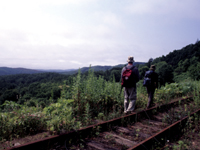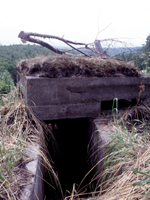Touring Sakhalin's Japanese Past
Back to Contents of Issue: November 2003
|
|
|
|
by David Wolman |
|
|
Sakhalin Tours is still struggling to get back on its feet, but things are looking up for local tourism thanks to increased outside interest in the monstrous oil and gas projects now underway on the island, as well as the continued success of student exchanges and tours catering to the Japanese. Before the lower half of the island was annexed by the Soviets at the end of World War II, the section of Sakhalin below the 55th parallel was a Japanese possession, and many elderly Japanese now living in Hokkaido were born and raised on the island (then known as Karafuto).
With classic Russian stubbornness, Vasilievna refuses to reveal her age, though I guess she's in her late 50s. She's been to Japan more than 40 times for various training programs and cultural exchanges.
Surrounded by a few cacti and the operation's only fax machine and computer, she compares the reactions of former residents with those who visit just to explore Russia and Sakhalin's vast wilderness.
"When the Japanese tourists come for the specific purpose of visiting grave sites, memorials or former temples, sometimes the scene becomes melancholic, and it's hard to raise their spirits. But of course those who're here to explore nature usually have a much more pleasant time discovering the wonders of the island."
For the Japanese who grew up here, the trip is a voyage into the landscape and memories of their youth. The old military hospital in Yuzhno-Sakhalinsk -- formerly Toyohara -- is still in use, as are two local bridges and a few other buildings. One year a Japanese tour group discovered that a furniture store had been erected on the exact spot where a Japanese shrine once stood. Before leaving, the tourists laid flowers on the building's steps.
The regional museum is also a big hit. Although it was built as a museum from the start, the Japanese used it as military headquarters during the latter part of the war. After the Soviets annexed the lower part of the island, the building was turned back into a museum, and about 80 percent of the exhibits today cover the history of the island before the war. Inside are impressive displays depicting the geographical, natural and aboriginal history of the island, all on the first floor, with the second floor devoted to Russian history, World War II and modernization.
"Whereas the villages we grew up in have mostly vanished, we know for certain that the museum was here back in the day, so it's an important place for us," says 73-year-old Toshichi Morikawa, who lived on Sakhalin until he was 20. Morikawa is vice chairman of the Hokkaido Japan-Russia Association in Sapporo, which coordinates cultural exchanges with the help of Sakhalin Tours.
A few museum highlights worth noting are the island's only wolf, which apparently braved a crossing over the sea ice from Siberia only to be shot, stuffed and encased as an exhibit, Japanese samurai swords and copies of Russian and Soviet documents that not-so-subtly fuel the flames of the dispute between Russia and Japan over possession of the South Kuril Islands.
As for Vasilievna's favorite moments with Japanese tourists, she says it's hard to choose. One year a group visited a beach in August, just when the salmon runs were peaking. As the salmon fought their way upriver, the Japanese were astounded by this spectacle of unspoiled nature so close to the city. They were equally thrilled by the huge servings of salmon roe provided by their Russian hosts. During trips to liquor and chocolate factories, the Russian hosts didn't just show the tour groups their operations, but also provided huge spreads for their guests. "Perhaps the Japanese were a little surprised by Russian hospitality." "Before they [the Japanese] go to Sakhalin, many have an image of Russia and Russians that was created in the days of the iron curtain," adds Morikawa. "They think maybe the people are strict and unwelcoming. But once they get to Sakhalin, they see that that's not true and that Russians are friendly and easy to get along with."
Many are also surprised by the number of Japanese cars on Sakhalin (around 90 percent of the cars here are Japanese) and by the unspoiled wilderness so close to Yuzhno-Sakhalinsk. On a few occasions, groups have visited locations outside the city to search for the sites of former villages, most of which are now overgrown with vegetation. Still another group made the nearly 1,000-meter hike up Peak Chekhov, overlooking the city.
Their guide that day was Sergey Kurnikov, who recalls the determination that the elderly participants brought to the hike. Kurnikov didn't need an interpreter to understand how happy they were to reach the peak -- to see the city and the landscape of their youth cradled by the valley below.
"At one point I told them we'd take a bathroom break," recalls Kurnikov over a cup of tea in his Yuzhno-Sakhalinsk apartment. "Through the translator I said the men would be over there and the women over there -- for the sake of privacy. We were maybe three-quarters of the way up the mountain at the time. Then, on the way back down a couple hours later, people split off again in the exact same spot, as if that were the only place on the mountain where they were allowed to relieve themselves! I was very impressed with their discipline."
The Japanese trips are paid for by the Hokkaido Japan-Russia Association, which runs student exchanges and welcomes Russians to Hokkaido as well. Vasilievna's agency has started to bring tour groups to local schools, where the Japanese often deliver gifts and Russian children perform a concert for their guests.
Despite the seasonal nature of tourism in Sakhalin -- few tourists seem interested in visiting during the harsh winter -- Vasilievna is hopeful that the new hotel, complete with shops, a restaurant and a casino, will help boost business, together with more outside interest in Sakhalin as oil and gas development continues. Meanwhile, the Japanese will keep coming, year after year, to learn and to share with their Russian neighbors.
"Younger generations of Russians here don't know a lot of the Japanese history," Vasilievna says, contemplating the often underexamined ties between the two cultures. "But as these older Japanese people walk around town, they start remembering things about what was where. The Japanese help teach us the true history of Sakhalin." @
|
|
Note: The function "email this page" is currently not supported for this page.


 AMID THE RACKET OF construction crews gutting and refurbishing the Sakhalin Tourist Hotel in Yuzhno-Sakhalinsk, Marina Vasilievna explains that business at the hotel's travel agency was much better during Soviet times. Back then, the regional government owned and operated local resorts, and the socialist system assured that people would go on holiday. Much of that stability crumbled during the days of perestroika. Faced with capitalism, many resorts went either independent or belly-up.
AMID THE RACKET OF construction crews gutting and refurbishing the Sakhalin Tourist Hotel in Yuzhno-Sakhalinsk, Marina Vasilievna explains that business at the hotel's travel agency was much better during Soviet times. Back then, the regional government owned and operated local resorts, and the socialist system assured that people would go on holiday. Much of that stability crumbled during the days of perestroika. Faced with capitalism, many resorts went either independent or belly-up.
 Do the Japanese have problems during their visits because Sakhalin is grittier than what they're used to, because food, accommodations and hot water are not 100 percent dependable here, or because of other cultural barriers? Rarely, says Vasilievna (or at least, never outwardly so). Careful preparations by her team help ensure that the program activities and menu are tailored to meet Japanese demands. "Most of the Japanese seem to like Russian foods like borsch and belini, and we serve a lot of fish and rice because we know they like them." Besides, adds Morikawa, most Japanese visitors remember wartime, when life was much tougher, so they don't have problems visiting modern-day Sakhalin.
Do the Japanese have problems during their visits because Sakhalin is grittier than what they're used to, because food, accommodations and hot water are not 100 percent dependable here, or because of other cultural barriers? Rarely, says Vasilievna (or at least, never outwardly so). Careful preparations by her team help ensure that the program activities and menu are tailored to meet Japanese demands. "Most of the Japanese seem to like Russian foods like borsch and belini, and we serve a lot of fish and rice because we know they like them." Besides, adds Morikawa, most Japanese visitors remember wartime, when life was much tougher, so they don't have problems visiting modern-day Sakhalin.



